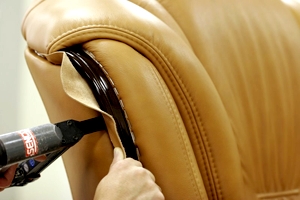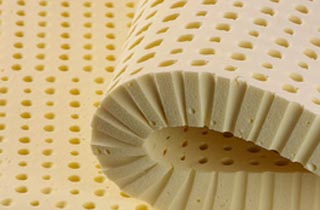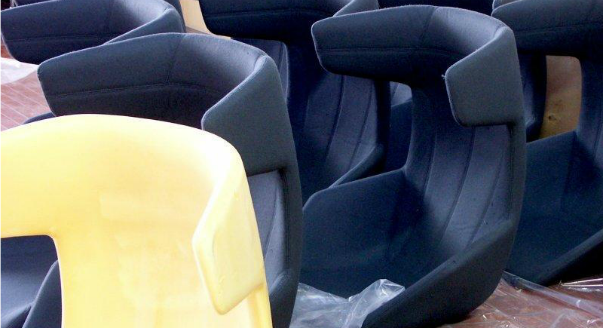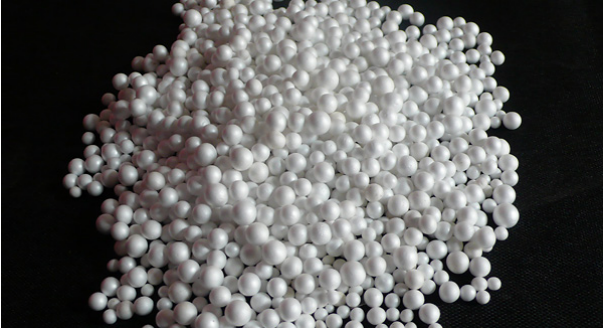Remember the fairy tale about the princess and the pea? Truly, the young lady was an expert in high-quality fillings for sofas. Such dexterity will not hurt you either. After all, sleeping or sitting on an uncomfortable sofa is not a rewarding task. In order not to carry out sleepless nights, like a princess from a fairy tale, let’s figure out what affects the comfort of the sofa.
Types of sofa fillers
Advantages of padding polyester low price,
Flaws The synthetic winterizer does not hold its shape very well and can wrinkle under significant loads. The production of synthetic padding polyester does not have a uniform standard; as a result, you can end up with products of low quality and with additives that are harmful to health, which can result from the use of recycled materials in production.
Sintepooh
Obtained by combing and twisting polyester fibers. As a result of combing, a material is formed that is similar in appearance to natural fluff. The combed fibers are treated with silicone and combined. The material has good volume and softness. Interestingly, synthetic down has higher rates of heat conservation and maintaining the shape of the product than its natural counterpart. For this reason, it is often used for the manufacture of warm outerwear.
In sofas, synthetic down is used to fill pillows and armrests.
To the advantages Synthetic fluff can be attributed to the fact that it holds its shape well and prevents the formation of fungi inside the sofa.
Comforel
Synthetic small balls are made of polyester fibers. Used to fill sofa cushions, chairs, ottomans and armchair bags.
Durafil
A synthetic material obtained by heat treatment and gluing fibers to a base. In this case, the fibers “grow” vertically from the base like grass. Due to this, the material has good elasticity and shape retention.
Advantages does not absorb moisture, has good fire resistance, and has antibacterial properties
 It is a canvas with a large volume. It can be made from natural fibers - cotton or wool, or from synthetic polyester.
It is a canvas with a large volume. It can be made from natural fibers - cotton or wool, or from synthetic polyester.
Visually, the material resembles a lush wool blanket. The material can have different densities, due to which sofas with Periotec can have different hardness
Development of Russian scientists. Appeared in 2004. Holofiber is registered as trademark. Thanks to your unique properties and at an acceptable price, holofiber is gradually displacing other synthetic fillers from the market.
The material is produced by twisting and splicing synthetic fibers. As a result, a spiral-shaped filler is formed which has many internal air pores. At the same time, the material has a homogeneous structure, due to which it holds its shape well and retains heat.
In the furniture industry it is used to fill sofa cushions. and sofa seats.
Advantages:Does not absorb moisture, Does not deteriorate in the sun, Does not absorb odors. Prevents fungus from spreading. Environmentally friendly It has self-healing properties - it takes on its original form after removing the load.
Natural latex
 Latex is obtained from the sap of the rubber tree. When vulcanized, latex forms a cellular structure with millions of cells, which are responsible for hygroscopicity and air exchange.
Latex is obtained from the sap of the rubber tree. When vulcanized, latex forms a cellular structure with millions of cells, which are responsible for hygroscopicity and air exchange.
Latex is very durable and durable material, does not cause allergies.
The main disadvantage is the high price. Therefore, latex is usually used in the production of expensive furniture.
Foam rubber fillers
 Foam rubber is one of the old and budget types fillers. Foam rubber can be used in the form of small pieces that fill the frame of the sofa or in the form of sheets when the sheet of foam rubber is equal to the size of the sofa element.
Foam rubber is one of the old and budget types fillers. Foam rubber can be used in the form of small pieces that fill the frame of the sofa or in the form of sheets when the sheet of foam rubber is equal to the size of the sofa element.
The filling with pieces quickly rolls off and begins to sag. Therefore, it is better to take a sofa with sheet foam rubber.
Foam rubber is often used as an additional layer in the construction of sofas.
General disadvantage of foam rubber short service life; during use, the foam rubber loses its shape and gets dented.
To dignity can be attributed to the low price.
Which filler for upholstered furniture is best?
This question can be answered by comparing fillers according to certain criteria. And within each of the selected criteria, find a leader.
The best filler in terms of service life
If the filler was produced using quality materials, then there is no clear leader. Both spring blocks and polyurethane foam will serve well. Foam rubber noticeably lags behind
Typically service life
- Spring blocks are 7-10 years old.
- PPU 5-8 years.
- Holofiber 5-10 years
- Foam rubber 3-5 years
When buying a sofa, always find out the density of the filling. The higher the density, the better. The lifespan of the sofa depends on the density.
The best fillings depending on the purpose of the sofa
The choice of filling also depends on the main purpose of the sofa.
- If the sofa is planned to be used for sleeping, then it is better to choose models whose fillers are independent spring blocks. It will be good to sleep on latex.
- Sofas for intense seating- suitable filler from spring blocks and from polyurethane foam and holofider
- Sofas with light load and occasional use. all the fillers described will cope with this task. Therefore, you can save money.
The best filler based on price criteria
The clear leader here is foam rubber. It's the cheapest. Then there are fillers made of padding polyester and holofiber, followed by polyurethane foam, and spring blocks close the group. Although there is an even more expensive material, latex.
BackUnfortunately, over time, even the most expensive and beloved furniture loses its original appearance and comfort. Scuffs appear on the backs and seats, and dents and dips appear in the most favorite places. The upholstery fabric loses its shine and beauty, and the inner foam filler wears out, becomes thin and crumbles. But if the main wooden frame furniture is still durable and the performance of the mechanisms is not satisfactory, then you can give your favorite furniture a second chance by updating upholstery fabric and will replace the filler - foam rubber.
Depending on the type and design of the furniture, repair work can be performed either independently or with the help of specialized companies.
Do-it-yourself replacement of foam rubber in chair seats
Replacing foam rubber on chair seats The simplest type of furniture repair that you can do yourself. Even a non-professional can cope with this task. The main thing is to prepare tools and materials for repairs in advance:
- upholstery;
- foam;
- construction stapler with staples;
- screwdriver, pliers, scissors.
The most common types of upholstery fabrics are flock, velor, courtesan, jacquard and tapestry. Foam rubber for chairs is chosen with a thickness of 20-40mm and a density of 30-40kg/m3.
Read more about the types and selection of furniture foam rubber in the article “Furniture foam rubber”.
The procedure for replacing foam rubber and chair upholstery:
- Completely disassemble the seat and back of the chair. With the seat turned over, pull out all the brackets and release old upholstery, remove all the old pieces of foam rubber, take out the extra staples;
- Cut a piece of foam rubber to fit the size of the seat. Make a pattern for the new upholstery with a margin of 4-5 cm on all sides for hemming and fastening with brackets;
- Spread the upholstery pattern on a flat surface, place the foam in the center, and place the chair seat on top. Gently and evenly stretch the upholstery and secure it with brackets on back side seats. Secure the corners of the seat without creases or large folds. Remove excess upholstery fabric;
- Assemble the chair seat with back and legs.
Replacing foam rubber in a sofa

Replacing furniture foam in a sofa or chair will require a much more serious approach. If you have no repair experience upholstered furniture, then due to the large number painstaking work When reupholstering sofas and armchairs, we advise you to contact furniture repair professionals. Today there are many companies on the market that are ready to replace foam rubber or complete renovation upholstery both at your home and on your territory.
Choice furniture fabric and foam rubber you can entrust to professionals or purchase all the materials yourself in specialized stores to suit your taste, taking into account the requirements for furniture materials.
Our company's consultants will help you calculate, select and purchase required material for repairing any upholstered furniture.
Our assortment always includes:
It's no secret that over time, even the highest quality foam rubber, padding polyester and other materials become dented and become unusable. But the furniture you had is still suitable for you. What to do? Replacing the filler will be the savior of your old furniture.
Rules for replacing foam rubber
Replacing foam rubber in the seats and backs of furniture requires compliance with several rules:
- 1 When buying foam rubber, pay attention to its thickness and density, the service life of the material depends on them,
- 2 When purchasing filler, take into account the allowances and the fact that the foam is laid in two layers,
- 3 When you remove old litter, do not leave even the slightest particle of it. If you do not do this, unevenness will appear after the upholstery,
- 4 Remove all old staples, otherwise the new foam may be damaged.
- 5 When cutting foam rubber, make an allowance for inner part, there is no need to do this on other sides,
- 6 Highly elastic foam rubber with increased comfort, or synthetic latex, is the best foam rubber for upholstered furniture in living rooms. It is mainly used for the manufacture of premium furniture.
- 7 If the furniture has a spring block, then place dense fabric between it and the foam rubber to prevent rapid abrasion of the filler.
Do you see how many nuances there are when replacing the filling in a sofa? If you are confident in your material and moral capabilities, then we wish you good luck. But it will be better if you entrust this to professionals.
Stages of replacing filling in furniture
Most often, foam rubber is used as furniture filler. How to replace it? What are the main stages? What should you pay attention to? Replacing foam rubber in furniture occurs in the following order:
- - Disassemble furniture into parts,
- - Remove the upholstery from those parts where replacement is needed,
- - Select the fabric and make a pattern using parts of the old upholstery,
- - Remove the old filler and replace with new foam rubber,
- - Reupholstery or partial upholstery of furniture,
- - Assembly.
Replacing the foam rubber of sofas at home with your own hands should be done with great care. The slightest deviation from the sequence or rules will lead to large losses (damage to upholstery or filling). You shouldn’t take risks; it’s better to let our specialists change the foam in your sofa or chair.
Designations of foam rubber brands:
- ST – standard foam rubber, short and medium service life
- EL – increased rigidity, medium and long service life
- HS – soft, short-life, softening flooring
- HL – extra hard, long service life, for orthopedic bases
- HR – highly elastic, long service life
- VE – viscoelastic, softening flooring, orthopedic pillows
Why us? There are 5 reasons for this:
- - Professionalism,
- - Quality of performance of any work (from simple to complex),
- - Individual approach. It is possible to work on weekends and weekdays, at a time convenient for you, in the workshop and at home,
- - Affordable price,
- - Working with the latest tools.
Using the services of our craftsmen, you will receive an updated sofa, armchair, pouf, etc. Allow yourself to once again become the owner of soft and comfortable furniture.
Buyers search for furniture based on clothing. Whereas internal organization(furniture filler) is much more important. After all, it is the filler that determines the hardness and softness of the seat, and the service life of the sofa largely depends on it. Choose your “filling” wisely. Otherwise, in a couple of years you risk getting a chair that has been sitting out for a long time with beautiful upholstery.
- 1 of 1
On the picture:
To prevent characteristic dents “from the butt” from remaining on the chair and sofa, it is important to choose a model with the right filling.
Furniture filler: classification
There are two common designs for upholstered furniture seat filling: with spring block and without springs. In the first case, continuous weaving springs are “wrapped” in several layers of covering materials: coconut coir, horsehair, polyurethane foam (PUF), etc. Various densities each layer allows you to create harder or, conversely, softer seat and back cushions. In the case of springless fillers, a block of cast polyurethane foam acts as the “core”.
Where is your case? Pay attention to the presence or absence of a technical cover under the upholstery, especially if the latter can be removed. The fact is that under the influence of light, polyurethane foam is destroyed, begins to turn yellow and crumble. If the pillows are left “in the air” even for a short time while the cover is being washed, the upholstered furniture will not last even a couple of years. A priori, a technical cover is available in all “multi-layer” pillows made of block PPU. They also make it in seats with molded polyurethane foam, which is supplemented with a layer of comfort.
In the photo: Decor sofa from Camelgroup factory.
The second type is cast polyurethane foam. It is done directly on furniture factory: a composition reminiscent of sour cream in consistency is filled into the workpiece. Begins chemical reaction, and the polyurethane foam hardens under pressure. And at the output we have a block exactly in size and shape sofa cushion: no cuttings or waste! But cast polyurethane foam also has a drawback: a characteristic “crust” forms on the surface of the block, which does not breathe well.
Cast polyurethane foam is cast strictly according to the shape of the product or its individual parts - for each chair or pillow they make their own blank (a chemical reaction occurs in it). Products weird shape otherwise it simply cannot be made. This significantly increases the cost of a sofa or chair.

- 1 of 1
On the picture:
Example of cast polyurethane foam: the blank completely follows the contour of the future chair.
Density of polyurethane foam. The density of polyurethane foam is decisive. The average range is from 30 to 40 kg/m³: the higher this figure, the harder and, therefore, more durable the upholstered furniture will be. The most delicate polyurethane foam for furniture (less than 25 kg/m³) is only suitable for decorative pillows. The “contents” of the seat of a chair or sofa can be clarified using the model passport. Many manufacturers offer several options to choose from or allow you to replace the basic hard components with softer ones. Filling with layers of block polyurethane foam for furniture is cheaper than cast foam.
In the photo: Armchair Vol au Vent (SVL / SV) from the B&B Italia factory, design Bellini Mario.
Trademarks of polyurethane
The composition of polyurethane foam is not the same. The Russian generic name “polyurethane foam” corresponds to many foreign analogues: lokfoam, vibrofoam, baltex, technolate, foamex (USA), moltoprene (Germany), allofoam (Canada). Some pillows have memory foam filling. They know how to keep their shape and literally envelop the person sitting, adapting to the curves of the body. But as soon as you rise, the filling quickly “straightens out”, taking its original position.
Alternative to furniture polyurethane foam
There are two alternatives polyurethane foam filler. Firstly, these are polystyrene balls (resemble crushed foam plastic appearance). Most bean bags are made on their basis. The balls dry out quite quickly, and you have to periodically replenish them to the required volume: get ready for regular additional expenses.

- 1 of 4
On the picture:
Loose filler literally envelops the body. Sitting in such a chair is incredibly comfortable.
Secondly, it is natural latex - it is used in expensive upholstered furniture. When a demanding client fundamentally does not want to deal with synthetic materials. Latex is obtained from the sap of the rubber tree, or Hevea. When foaming, millions of cells are formed in its structure, which are responsible for hygroscopicity and air exchange. One of the advantages of the material is its durability: the service life of latex is over 10 years, while the traditional PU foam block is designed for only five years (maximum eight in expensive furniture). Another important quality of latex is hypoallergenic. However, the cost of a latex-based product is quite high.

- 1 of 1
On the picture:
Latex is rightfully considered the best filler for upholstered furniture. The only drawback- this is the high price of the finished product.




